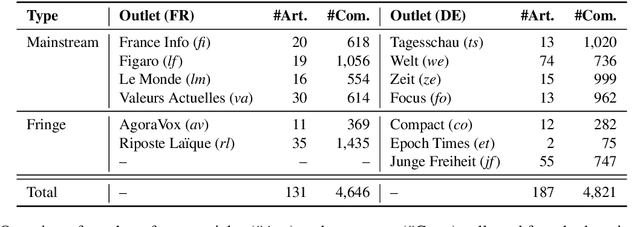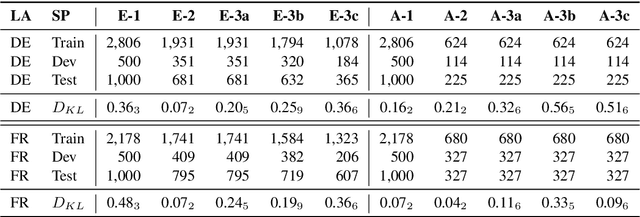Ashwin Geet D'Sa
Placing M-Phasis on the Plurality of Hate: A Feature-Based Corpus of Hate Online
Apr 28, 2022



Abstract:Even though hate speech (HS) online has been an important object of research in the last decade, most HS-related corpora over-simplify the phenomenon of hate by attempting to label user comments as "hate" or "neutral". This ignores the complex and subjective nature of HS, which limits the real-life applicability of classifiers trained on these corpora. In this study, we present the M-Phasis corpus, a corpus of ~9k German and French user comments collected from migration-related news articles. It goes beyond the "hate"-"neutral" dichotomy and is instead annotated with 23 features, which in combination become descriptors of various types of speech, ranging from critical comments to implicit and explicit expressions of hate. The annotations are performed by 4 native speakers per language and achieve high (0.77 <= k <= 1) inter-annotator agreements. Besides describing the corpus creation and presenting insights from a content, error and domain analysis, we explore its data characteristics by training several classification baselines.
HUMAN: Hierarchical Universal Modular ANnotator
Oct 02, 2020



Abstract:A lot of real-world phenomena are complex and cannot be captured by single task annotations. This causes a need for subsequent annotations, with interdependent questions and answers describing the nature of the subject at hand. Even in the case a phenomenon is easily captured by a single task, the high specialisation of most annotation tools can result in having to switch to another tool if the task only slightly changes. We introduce HUMAN, a novel web-based annotation tool that addresses the above problems by a) covering a variety of annotation tasks on both textual and image data, and b) the usage of an internal deterministic state machine, allowing the researcher to chain different annotation tasks in an interdependent manner. Further, the modular nature of the tool makes it easy to define new annotation tasks and integrate machine learning algorithms e.g., for active learning. HUMAN comes with an easy-to-use graphical user interface that simplifies the annotation task and management.
Towards non-toxic landscapes: Automatic toxic comment detection using DNN
Nov 19, 2019



Abstract:The spectacular expansion of the Internet led to the development of a new research problem in the natural language processing field: automatic toxic comment detection, since many countries prohibit hate speech in public media. There is no clear and formal definition of hate, offensive, toxic and abusive speeches. In this article, we put all these terms under the "umbrella" of toxic speech. The contribution of this paper is the design of binary classification and regression-based approaches aiming to predict whether a comment is toxic or not. We compare different unsupervised word representations and different DNN classifiers. Moreover, we study the robustness of the proposed approaches to adversarial attacks by adding one (healthy or toxic) word. We evaluate the proposed methodology on the English Wikipedia Detox corpus. Our experiments show that using BERT fine-tuning outperforms feature-based BERT, Mikolov's word embedding or fastText representations with different DNN classifiers.
An IoT Based Framework For Activity Recognition Using Deep Learning Technique
Jun 17, 2019



Abstract:Activity recognition is the ability to identify and recognize the action or goals of the agent. The agent can be any object or entity that performs action that has end goals. The agents can be a single agent performing the action or group of agents performing the actions or having some interaction. Human activity recognition has gained popularity due to its demands in many practical applications such as entertainment, healthcare, simulations and surveillance systems. Vision based activity recognition is gaining advantage as it does not require any human intervention or physical contact with humans. Moreover, there are set of cameras that are networked with the intention to track and recognize the activities of the agent. Traditional applications that were required to track or recognize human activities made use of wearable devices. However, such applications require physical contact of the person. To overcome such challenges, vision based activity recognition system can be used, which uses a camera to record the video and a processor that performs the task of recognition. The work is implemented in two stages. In the first stage, an approach for the Implementation of Activity recognition is proposed using background subtraction of images, followed by 3D- Convolutional Neural Networks. The impact of using Background subtraction prior to 3D-Convolutional Neural Networks has been reported. In the second stage, the work is further extended and implemented on Raspberry Pi, that can be used to record a stream of video, followed by recognizing the activity that was involved in the video. Thus, a proof-of-concept for activity recognition using small, IoT based device, is provided, which can enhance the system and extend its applications in various forms like, increase in portability, networking, and other capabilities of the device.
 Add to Chrome
Add to Chrome Add to Firefox
Add to Firefox Add to Edge
Add to Edge